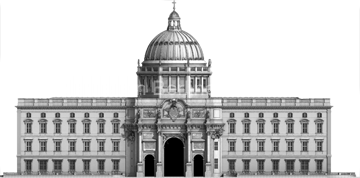As they were three hundred years ago, the palace façades are being created to old rules: first, every detail is modelled in clay. In the past, a mould release agent, generally shellac, was next brushed onto the model, from which a mould was then directly cast using plaster. Today, it is done differently: the clay model is coated in high-quality, liquid silicon.
Once it has dried, this is like a perfectly fitting rubber skin and is very flexible. Before it is taken off, a plaster corset is therefore built against the silicon skin. This keeps the mould stable after removal. It is only then that the conversion into sandstone occurs. The path taken has changed over time as a result of technical progress and better materials, but the historic trio of clay model, plaster model and sandstone execution has remained.
![berliner_extrablatt_ausgabe-83_low_seite_20_bild_0006[1]](https://berliner-schloss.de/en/wp-content/uploads/sites/2/2015/07/berliner_extrablatt_ausgabe-83_low_seite_20_bild_00061.jpg)
![berliner_extrablatt_ausgabe-83_low_seite_20_bild_0005[1]](https://berliner-schloss.de/en/wp-content/uploads/sites/2/2015/07/berliner_extrablatt_ausgabe-83_low_seite_20_bild_00051.jpg)
Models of eagles from the Schlüter façades’ mezzanine. 40 different eagles were modelled in clay and then coated in silicon for casting the moulds.
![berliner_extrablatt_ausgabe-83_low_seite_20_bild_00041[1]](https://berliner-schloss.de/en/wp-content/uploads/sites/2/2015/07/berliner_extrablatt_ausgabe-83_low_seite_20_bild_000411.jpg)
This large shot of Portal V in the Schlüter Courtyard shows the whole beauty of Schlüter’s architecture. He was sculptor and architect in one and therefore not unreasonably called the ‘German Michelangelo’.
Further links
Development of the façades in model form
Part I: Daring to rebuild Berlin Palace
Part II: Old photos show the palace’s original beauty
Part III: Façades being created in old sculpting tradition
 Deutsch
Deutsch English
English



